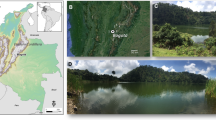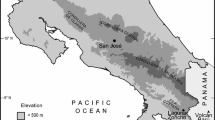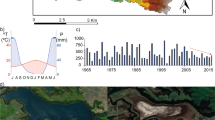Abstract
Shifts in an ecosystem’s state can alter biogeochemical cycling and the extent of nutrient conservation within a terrestrial landscape on multiple time scales. Transient biogeochemical changes may follow disturbance and succession, although persistent long-term differences may exist under different climates and vegetation types. We evaluate the potential for such biogeochemical changes in the context of long-term ecological history by measuring the nitrogen isotope composition of organic matter in a lake sediment core. We targeted Little Windy Hill Pond (LWH) in the Medicine Bow Mountains, Wyoming because reconstructions of the lake level, fire, and vegetation histories from the lacustrine sediments indicated a century-scale transformation from an arid, shrub-dominated landscape to a sub-alpine, tree-dominated ecosystem with extensive woody cover and large, live biomass pools. We demonstrate that the afforestation at the beginning of the Holocene transformed the Artemisia-dominated ecosystem, which had persisted for millennia during the Pleistocene. The changes affected nitrogen cycling dynamics, especially through intensified nutrient conservation when live biomass pools increased with greater woody cover. The LWH sediments record a baseline δ15N shift from 2.2–3.0 to 0.3–2.0‰ as less 15N-enriched organic matter accumulated in the lake. We also observed a transient pattern of maximum nutrient conservation and minimum δ15N values as terrestrial biomass increased during the aggradation (~175 years) and transition phases of ecological succession. Our nitrogen isotope results support theoretical expectations of long-term biogeochemical dynamics as nutrient conservation increases during afforestation.




Similar content being viewed by others
References
Amundson R, Austin AT, Schuur EAG, Yoo K, Matzek V, Kendall C, Uebersax A, Brenner D, Baisden WT. 2003. Global patterns of the isotopic composition of soil and plant nitrogen. Glob Biogeochem Cycles 17:1031.
Austin AT, Vitousek PM. 1998. Nutrient dynamics on a precipitation gradient in Hawai’i. Oecologia 113:519–29.
Austin AT, Yahdjian L, Stark JM, Belnap J, Porporato A, Norton U, Ravetta DA, Schaeffer SM. 2004. Water pulses and biogeochemical cycles in arid and semiarid ecosystems. Oecologia 141:221–35.
Baker WL. 1989. Landscape ecology and nature reserve design in the Boundary Waters Canoe Area, Minnesota. Ecology 70:23–35.
Bormann FH, Likens GE. 1979. Ecosystem development and the steady state. In: Pattern and process in a forested ecosystem. New York: Springer. p. 164–91.
Bowman WD, Theodose TA, Schardt JC, Conant RT. 1993. Constraints of nutrient availability on primary production in two alpine tundra communities. Ecology 74:2085–97.
Bunting L, Leavitt PR, Weidman RP, Vinebrooke RD. 2010. Regulation of the nitrogen biogeochemistry of mountain lakes by subsidies of terrestrial dissolved organic matter and the implications for climate studies. Limnol Oceanogr 55:333.
Cambui CA, Svennerstam H, Gruffman L, Nordin A, Ganeteg U, Näsholm T. 2011. Patterns of plant biomass partitioning depend on nitrogen source. Weigelt A, Ed. PLoS One 6:e19211.
Compton JE, Hooker TD, Perakis SS. 2007. Ecosystem N distribution and δ15N during a century of forest regrowth after agricultural abandonment. Ecosystems 10:1197–208.
Dunnette PV, Higuera PE, McLauchlan KK, Derr KM, Briles CE, Keefe MH. 2014. Biogeochemical impacts of wildfires over four millennia in a Rocky Mountain subalpine watershed. New Phytol 203:900–12.
Enders SK, Pagani M, Pantoja S, Baron JS, Wolfe AP, Pedentchouk N, Nunez L. 2008. Compound-specific stable isotopes of organic compounds from lake sediments track recent environmental changes in an alpine ecosystem, Rocky Mountain National Park, Colorado. Limnol Oceanogr 53:1468.
Faegri K, Kaland PE, Krzywinski K. 1989. Textbook of pollen analysis. Chichester: Wiley.
Fahey TJ, Knight DH. 1986. Lodgepole pine ecosystems. Bioscience 36:610–7.
Ford MSJ. 1990. A 10 000-yr history of natural ecosystem acidification. Ecol Monogr 60:57–89.
Garten CT. 1993. Variation in foliar 15N abundance and the availability of soil nitrogen on Walker Branch watershed. Ecology 2098–113.
Gorham E, Vitousek PM, Reiners WA. 1979. The regulation of chemical budgets over the course of terrestrial ecosystem succession. Annu Rev Ecol Syst 10:53–84.
Haslett J, Parnell A. 2008. A simple monotone process with application to radiocarbon-dated depth chronologies. J R Stat Soc 57:399–418.
Higuera PE, Gavin DG, Bartlein PJ, Hallett DJ. 2010. Peak detection in sediment–charcoal records: impacts of alternative data analysis methods on fire-history interpretations. Int J Wildland Fire 19:996.
Hobbie EA, Ouimette AP. 2009. Controls of nitrogen isotope patterns in soil profiles. Biogeochemistry 95:355–71.
Högberg P, Johannisson C. 1993. 15N abundance of forests is correlated with losses of nitrogen. Plant Soil 157:147–50.
Jeffers ES, Bonsall MB, Willis KJ. 2011. Stability in ecosystem functioning across a climatic threshold and contrasting forest regimes. Moen J, Ed. PLoS One 6:e16134.
Kashian DM, Turner MG, Romme WH, Lorimer CG. 2005. Variability and convergence in stand structural development on a fire-dominated subalpine landscape. Ecology 86:643–54.
Lipson DA, Schmidt SK, Monson RK. 1999. Links between microbial population dynamics and nitrogen availability in an alpine ecosystem. Ecology 80:1623–31.
Martinelli LA, Piccolo MC, Townsend AR, Vitousek PM, Cuevas E, McDowell W, Robertson GP, Santos OC, Treseder K. 1999. In: Nitrogen stable isotopic composition of leaves and soil: tropical versus temperate forests, Vol. 46. Springer: Netherlands. p. 45–65.
McLauchlan KK, Hobbie SE. 2004. Comparison of labile soil organic matter fractionation techniques. Soil Sci Soc Am J 68:1616–25.
McLauchlan KK, Craine JM, Oswald WW, Leavitt PR, Likens GE. 2007. Changes in nitrogen cycling during the past century in a northern hardwood forest. Proc Natl Acad Sci 104:7466–70.
McLauchlan KK, Lascu I, Myrbo A, Leavitt PR. 2013a. Variable ecosystem response to climate change during the Holocene in northern Minnesota, USA. Geol Soc Am Bull 125:445–52.
McLauchlan KK, Williams JJ, Craine JM, Jeffers ES. 2013b. Changes in global nitrogen cycling during the Holocene epoch. Nature 495:352–5.
McLauchlan KK, Higuera PE, Gavin DG, Perakis SS, Mack MC, Alexander H, Battles J, Biondi F, Buma B, Colombaroli D, Enders SK, Engstrom DR, Hu FS, Marlon JR, Marshall J, McGlone M, Morris JL, Nave LE, Shuman B, Smithwick EAH, Urrego DH, Wardle DA, Williams CJ, Williams JJ. 2014. Reconstructing disturbances and their biogeochemical consequences over multiple timescales. Bioscience 64:105–16.
Menge DNL, Pacala SW, Hedin LO. 2009. Emergence and maintenance of nutrient limitation over multiple timescales in terrestrial ecosystems. Am Nat 173:164–75.
Meyers PA, Ishiwatari R. 1993. Lacustrine organic geochemistry—an overview of indicators of organic matter sources and diagenesis in lake sediments. Org Geochem 20:867–900.
Meyers PA. 1994. Preservation of elemental and isotopic source identification of sedimentary organic matter. Chem Geol 114:289–302.
Minckley TA, Shriver RK, Shuman BN. 2012. Resilience and regime change in a southern Rocky Mountain ecosystem during the past 17,000 years. Ecol Monogr 82:49–68.
Overpeck JT, Webb TIII, Prentice IC. 1985. Quantitative interpretation of fossil pollen spectra: dissimilarity coefficients and the method of modern analogs. Quat Res 23:87–108.
Pastor J, Post WM. 1986. Influence of climate, soil moisture, and succession on forest carbon and nitrogen cycles. Biogeochemistry 2:3–27.
Pearson JA, Knight DH, Fahey TJ. 1987. Biomass and nutrient accumulation during stand development in Wyoming lodgepole pine forests. Ecology 68:1966–73.
Pribyl P, Shuman BN. 2014. A computational approach to Quaternary lake-level reconstruction applied in the central Rocky Mountains, Wyoming, USA. Quat Res 82:249–59.
R Core Development Team. 2009. R: a language and environment for statistical computing. http://www.R-project.org.
Reich PB, Grigal DF, Aber JD, Gower ST. 1997. Nitrogen mineralization and productivity in 50 hardwood and conifer stands on diverse soils. Ecology 78:335–47.
Robinson D. 2001. δ15N as an integrator of the nitrogen cycle. Trends Plant Sci 16:121–6.
Schimel JP, Bennett J. 2004. Nitrogen mineralization: challenges of a changing paradigm. Ecology 85:591–602.
Schindler DW. 2009. Lakes as sentinels and integrators for the effects of climate change on watersheds, airsheds, and landscapes. Limnol Oceanogr 54:2349.
Shuman BN, Carter GE, Hougardy DD, Powers K, Shinker JJ. 2014. A north–south moisture dipole at multi-century scales in the Central and Southern Rocky Mountains, USA, during the late Holocene. Rocky Mountain Geol 49:33–49.
Smithwick EAH, Kashian DM, Ryan MG, Turner MG. 2009. Long-term nitrogen storage and soil nitrogen availability in post-fire lodgepole pine ecosystems. Ecosystems 12:792–806.
Valett HM, Crenshaw CL, Wagner PF. 2002. Stream nutrient uptake, forest succession, and biogeochemical theory. Ecology 83:2888–901.
Vitousek PM, Matson PA, Van Cleve K. 1989. Nitrogen availability and nitrification during succession: primary, secondary, and old-field series. Plant Soil 115:229–39.
Vitousek PM, Reiners WA. 1975. Ecosystem succession and nutrient retention: a hypothesis. Bioscience 25:376–81.
Whitmore J, Gajewski K, Sawada M, Williams JW, Shuman BN, Bartlein PJ, Minckley T, Viau AE, Webb TIII, Shafer S, Anderson P, Brubaker L. 2005. Modern pollen data from North America and Greenland for multi-scale paleoenvironmental applications. Quat Sci Rev 24:1828–48.
Williams JW. 2002. Variations in tree cover in North America since the last glacial maximum. Glob Planet Chang 35:1–23.
Williams JW, Jackson ST. 2003. Palynological and AVHRR observations of modern vegetational gradients in eastern North America. Holocene 13:485–97.
Williams JW, Shuman BN. 2008. Obtaining accurate and precise environmental reconstructions from the modern analog technique and North American surface pollen dataset. Quat Sci Rev 27:669–87.
Acknowledgements
The authors acknowledge the funding through NSF grants from Geography and Spatial Sciences (CAREER Award BCS-0845129) and Ecosystems (DEB-0816731) provided to BNS to conduct this research. The authors wish to thank A.K. Henderson and J.A. Fredrickson for their assistance in the field and lab, as well as the Univ. of Wyoming Stable Isotope Facility for providing analytical assistance. SLK was funded by NSF BCS 0845129 (to BNS) and the Univ. of Chicago T.C. Chamberlin Fellowship.
Author information
Authors and Affiliations
Corresponding author
Additional information
Author contributions
BNS and TAM conceived the study; BNS, TAM, and JPM performed the research; SLK and BNS analyzed data and wrote the paper.
Rights and permissions
About this article
Cite this article
Kim, S.L., Shuman, B.N., Minckley, T.A. et al. Biogeochemical Change During Climate-Driven Afforestation: A Paleoecological Perspective from the Rocky Mountains. Ecosystems 19, 615–624 (2016). https://doi.org/10.1007/s10021-015-9955-9
Received:
Accepted:
Published:
Issue Date:
DOI: https://doi.org/10.1007/s10021-015-9955-9




